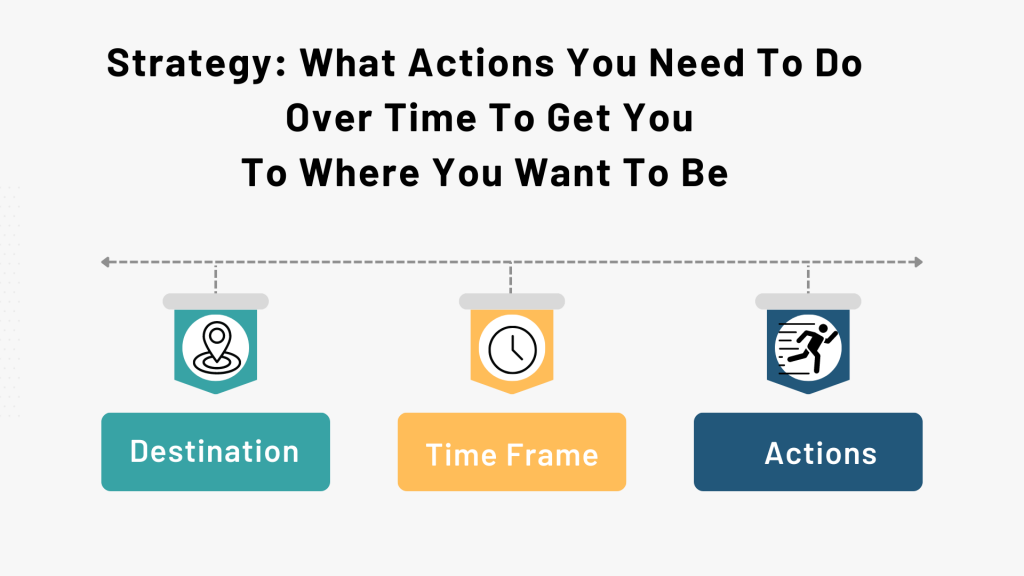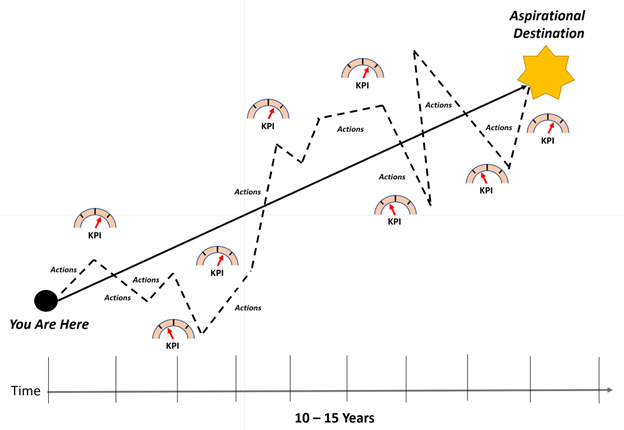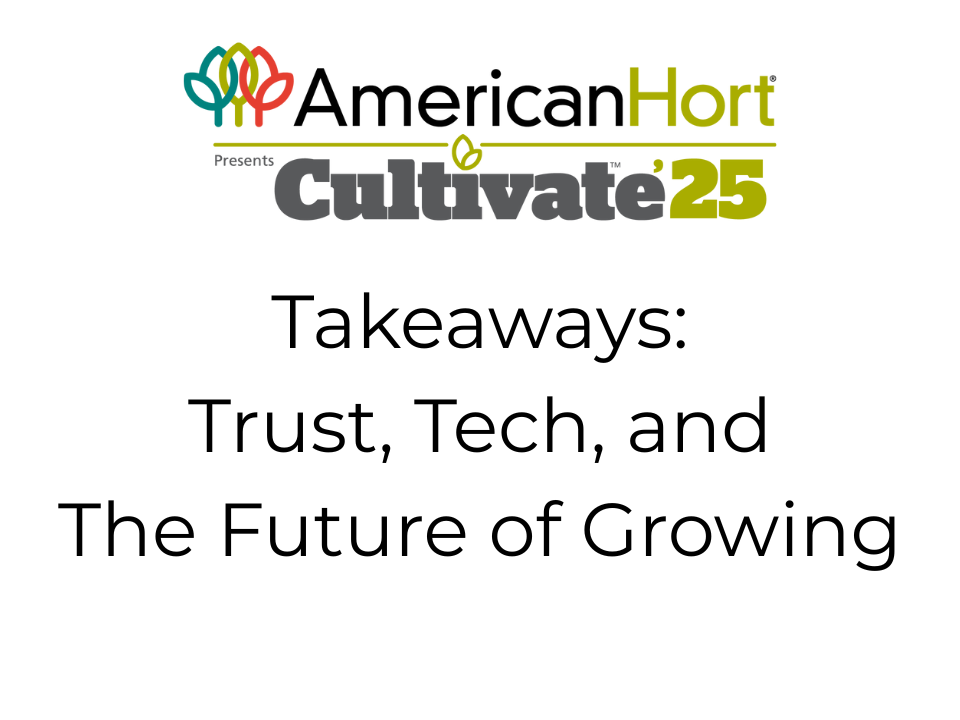
Is Your Grower Inventory Availability Impossible To Manage?
April 14, 2023
Top Four Most Important Insights from the Nursery Management State of the Industry Report
May 22, 2023One definition of insanity is doing the same thing over and over again but expecting different results.
Too many times growers succumb to “just do what we did last year” as a strategy due to the sheer volume of decisions, high levels of uncertainty with customers and weather and difficulty level of detailed planning, forecasting, and sourcing analysis.
But doing what you did last year will not drive you to achieve different results. It takes dedicated effort to change direction. But where do you start? What do you do? How much time do you spend thinking about strategy? Do you have a written strategic plan?
The average small business owner spends less than 30% of their time planning and executing a strategic plan. Many spend less than 10% of their time on strategy.
I asked Rob Ferguson, founder of Ferguson Alliance and noted business advisor to several large growers, among many clients, about how much time executives should be spending on strategy and he said:
“Leaders should spend most of their time on strategy (strategic planning, strategic managing, and strategic financing). Aligning employees to the strategy takes an inordinate amount of time.”
– Rob Ferguson, founder of Ferguson Alliance
It takes a lot of time to do strategy right. And strategy and all its corollary parts in the business can be complex and overwhelming to new initiates. So lets break down the big problem of strategy in to some smaller, simpler pieces to make the ideas more manageable.
According to the Cambridge Dictionary strategy is defined as:
“The way in which a business, government or other organization carefully plans its actions over a period of time to improve its position and achieve what it wants.”
– Cambridge Dictionary
In this very simple model from the definition above there are three elements to thinking about strategy:
- destination – where do you want to be – ‘to achieve what it wants“
- time frame – what time period are you considering to get there – ‘period of time“
- actions – activities that take you toward your destination – “carefully plans its actions“
Simple right?
We will start at the end, the strategic destination, and work backward.

Your Strategic or Aspirational Destination
The first element of strategy consideration is deciding where you want to be or what your end state will be.
What do you aspire your company to be? Where do you want to be? What do you want your business to become or attain?
It’s your longer-term destination as it were.
In the acclaimed book 7 Habits of Highly Effective People, author Stephen Covey says the second habit of highly effective people is to “Begin with the end in mind”. That end is the destination.
Do you want to be the market leader? Attain a certain business size or market share? Win awards? Have the best quality or employee culture? Grow the business and sell or pass along to your heirs? Achieve a certain EBITDA? Have a higher customer satisfaction rating? Contribute new genetics or exiting new product introductions?
All of these (and many more) are part of the considerations for your destination, that aspirational vision you seek.
A business without a clear end destination or result in mind is like a boat with no oars or rudder, its left to the mercy of the wind and currents.
Your destination is what you aspire to be as a business.
Your Strategic Time Frame
The second element of strategy is the time frame.
For most businesses aspirational strategic thinking and planning should cover many years.
In periods of great uncertainty like we now face and have faced in the last few years in our world, its tempting to narrow the time frame of consideration. But I would encourage you to think past the current situations and identify what you want your business to be in a longer time frame.
The destination we referred to in the prior section that is your vision for what you want to be and it could take a while to get there.
A true visionary perspective can be as long as 10-15 years or longer. Mayoshi Sun, leader of SoftBank investment firm has stated they have a 300 year plan. I don’t advocate our growers start with a 300-year plan but something more manageable.
Most of the growers and live goods businesses we work with can start with a 10–15-year time horizon.
Certain aspects of your business such as looming big milestone life events can certainly alter that planning horizon. The point is it’s your aspirational vision and your destination but give yourself an appropriate time window to get there.
Remember, as you break down your strategic vision or destination into bite size tactical executable chunks, those tactical chunks will cover much shorter time periods. We all operate our business by the week or month or year. But, as those shorter time frame results accumulate, we want to make sure our directional heading is correct based on the strategic destination.
Your Strategic Actions
So, you have your strategic destination – your aspirational vision, and a timeframe to get there.
How do you do that? How do you decide the actions to take and the time frames of those actions? How do you break down that destination into manageable pieces?
Rob Ferguson, states it this way in a recent blog post:
“The simplest way to think about strategy is to answer this question: “How are you going to attack the market?”
How are you going to compete?
How are you going to grow value?
How are you going to add value?
The answers to these questions are best answered after conducting a thorough analysis of the business.
We recommend doing this collaboratively with a group of people from various functions and diverse levels of the organization to gain better insights.
By taking a structured approach to analysis, you uncover important factors that might otherwise be overlooked.”
– Rob Ferguson, Ferguson Alliance
As you work back from your destination with your team you will break down the “what” into the “how”.
For example, if your vision was to be the market share leader in your region, you have to look at what customers are buying, how do we increase production? What Sales efforts are needed to win new customers? And so on. Each one of those are further broken down into specific tactical, measurable efforts, that are designed to take you in the direction of your end goal.
Deciding the actions to achieve your aspirational destination is a team effort, and an iterative one as well. Working with your team to define, refine and break down these actions helps to unify the team and provide clarity on the collective expectations and direction.
As you iterate through the process you will end up with key result areas and key performance indicators which help you know specific things your team needs to do, as well as specific aspects to measure to know how you are doing.
It is these measurements that help establish your current situation and the trends of those measurements establish direction you are going and progress toward that destination you seek. The key performance indicators and key result areas are a big part of the management framework you will use to achieve your destination.

Copyright Advanced Grower Solutions
In the real world you make progress and fall back. You hit barriers and overcome them. You adjust to new, previously unknown circumstances. Your iterative strategic planning and measurements help you with indicators for course adjustments as you move forward.
How Do You Start?
This may seem like a lot, but as they say the journey of 1,000 miles begins with the first step. And regardless of whether you are a large grower or a small single greenhouse operation, you need to begin with the end in mind.
It is best to work with an experienced outsider that can view your business, and its current state with fresh eyes and help ask the right questions to help guide the formulation of your strategic destination, timeline, and actions.
A experienced, third-party observer can often see things you cannot, ask questions that need to be asked, and get more transparent feedback from team members giving you a more realistic picture of your business.
A third party can also help keep the team members on task of iterative strategic planning when the demands of day-to-day business pull you away.
Advanced Grower Solutions has experienced consultants, who have run both large and small growing operations selling to all manner of customers including nationwide retail chains. We can provide an understanding partner to help you assess, create, revise, and improve your strategic and tactical direction and operating results.
Learn more about our consulting capabilities. Our team can has Strategic and Operational Consulting specifically for growers. We can assess your technology and identify risks, Read about some of our custom projects we have completed here.
Contact us today for discussion on how you can start this transformative process.





